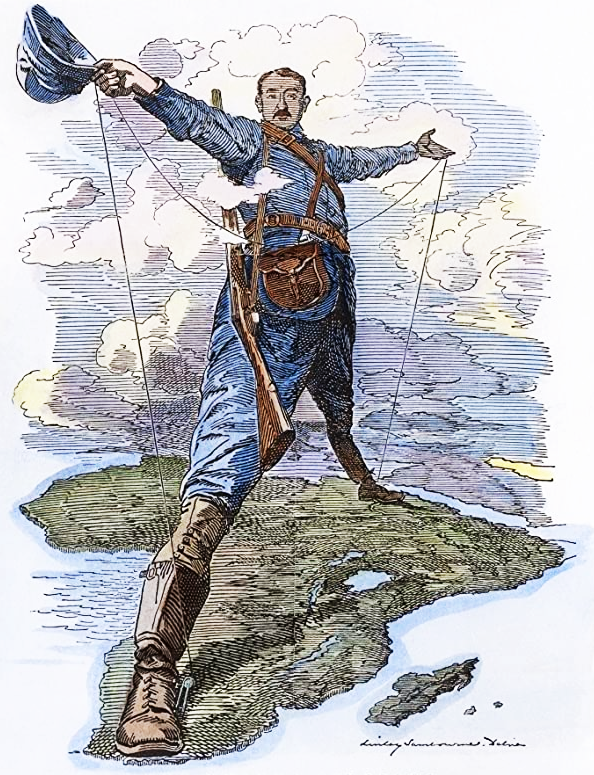Portugal and Spain dominated colonization till seventeenth century with a slogan “if a flag isn’t waving, it’s right for enslaving”. After the dynastic union of Kingdoms of Spain and Portugal under the Spanish Crown (1580–1640), Portuguese colonial trade and colonies were attacked by new competing colonial powers of Dutch, Britain and France. Enemies of Spain became enemies of Portugal. Several Portuguese colonies were taken over by Dutch namely Brazil, Ceylon and East Indies etc.
New wave of colonialism was dominated by France and Britain with the morality stated in nineteenth century by De Beers founder owner Cecil Rhodes “The more of the world we inhabit the better it is for human race”, although Raphael Lemkin, initiator of Genocide convention (1951), termed colonization as “intrinsically genocidal”. Enunciated such genocide as a two stage process; (i) first stage being the destruction of the indigenous population’s way of life and (ii) in the second stage, the newcomers impose their way of life on the indigenous people. Genocidal manifestation resulted in deliberate clearing of territories of their original inhabitants in order to make them exploitable for purposes of resource extraction and colonial settlements, and through enlisting indigenous peoples as forced laborers in colonial projects of resource extraction. Viceroyalties, Missionaries, seamen, slave traders, conquistadors/settler militias, slaves and forced workers were either governed by joint stock companies like East India Company or governing councils like in Iberian Peninsula kingdoms.
British-Spain naval war (1588), eighty years Dutch war of Independence from Spain (1568– 1648), Seven Years’ War (1756 – 1763) and Second Hundred Years’ War (1689-1815) between Great Britain and France engulfed the colonies around the Globe. Intense rivalry and completion was further complicated by religious divisions and conflicts between Catholics, Protestants and Huguenots in Western Europe. European geopolitical landscape effected the colonial leadership position, shifting from Portugal to Spain and finally after the defeat of Napoleon Bonaparte in 1815 to Great Britain. From Canada to Australia and from Chinese Coast to Cape of Good Hope British Empire was Supreme on land and sea. In the 17th century Americas, Britain occupied the Eastern part of the North America, French Eastern Canada and Central part of North America and some parts of Caribbean, and Spain the Western part of North America, Central America and Western part of South America all the way down to Argentina. Most of the Spanish colonies (35) gained independence before the first quarter of nineteenth century, although Cuba became independent in 1868 and Belize in 1981.
Portuguese Brazil gained independence in 1822, Mozambique in 1975, and Goa India annexed in 1961. Major Dutch colonies were New York, Indonesia, Ceylon, Formosa, Malacca, Cape Town, Ghana, Ivory Coast, Senegal, Angola, Mauritius, Vietnam, Japan and Brazil. After their defeat in Fourth Anglo-Dutch War (1780 – 1784), Dutch Republic lost most of its colonial possessions and trade monopolies to Britain. Its last major colony, Indonesia gained independence in 1949. Defeated France lost most of its colonial territories in North America and India to Britain after the Treaty of Paris in 1815. Their forced exit from Indo-China occurred in 1954.
Great Britain after the end of the Seven Years’ War with France in 1763, unchallenged on external front faced two movements within Britain in the second half of 18th century; the anti-slavery movement and the first Industrial revolution. Both changed the nature of future colonization. In 1776, British colonial project in North America encountered a major setback when 13 colonies on Atlantic coast of North America declared independence. French wholeheartedly supported the newly independent states against their archenemy Britain.
In 1803, USA bought Central North America region from France through ‘Louisiana Purchase’. Native Americans were also paid somewhat in excess of 800 million dollars, but this was nonetheless far lower than the true value of the land. An estimated 100,000 Indians were forced to vacate land after the discovery of Gold in their settlement areas.
Mexican-American war (1846 – 48) resulted in annexation of Texas and Northern half of Mexico including California. The Pacific expansion culminated in the annexation of Hawaii in 1898, and Alaska purchase from Russian Empire in 1867.
Ban on slavery in Europe resulted in two types of human trafficking, mass migration of Europeans and as indentured workers. Such workers were recruited from India, China and from the Pacific and signed a contract in their own countries to work abroad for 5 years or more. Early European settlers in colonies were religiously persecuted immigrants from Western and Northern Europe, as well as those opportune youngsters who felt upward mobility in Europe an impossibility. For better financial future, large number also migrated to Southern Africa in Nineteenth Century.
While in the preceding centuries, colonies and settlements were mainly along the coastline, well suited for slave trade. But with the decline in slave trade, spread of settlements went deep into the interior of the continents, thus providing room for settlers of Europe who then developed agriculture and industry of these lands under the social system imported from mother countries. Removal of the indigenous peoples by killing them off or forcing them into especially reserved areas were a natural consequence, as happened in North America and Southern Africa.
European Industrial products required new consumer markets, but colonial societies, with their largely self-sufficient small communities based on subsistence agriculture and home industry provided poor market for consumption; nor were the existing social systems flexible enough to introduce and rapidly expand the commercial agriculture (and later, mining) required to supply the raw material for the mother country. Hence an (1) overhaul of existing land and property arrangements, more suited for use by white settlers or for plantation agriculture, (2) creation of labor supply for commercial agriculture and mining by means of direct forced laborers, generating a body of wage-seeking laborers; (3) spread of the use of money, instead of barter, imposition of taxes and land rent and by inducing a decline of home industry; and (4) where the precolonial society already had a developed industry, curtailment of production and exports of native producers.
The classic illustration of this policy is found in India. For centuries India had been an exporter of cotton goods, to such an extent that Great Britain for a long period imposed stiff tariff duties to protect its domestic manufacturers from Indian competition. Yet, by the middle of the 19th century, from Britain’s mechanized production, India was receiving one-fourth of all British exports of cotton piece goods and had lost its own export markets.
Clearly, such significant changes could only be achieved by a sufficiently cooperative local elite, with effective administrative controls that would assure social stability despite imposition of radical social changes by a foreign power. Consistent with these purposes was the installation of new, or amendments of old, legal systems that would facilitate the operation of money, business and land economy. Tying it all together was the imposition of the culture and language of the dominant power; Great Britain in case of India.
British East India Company entered India as a trading house. Mughal India produced about 25 percent of global industrial output into the early 18th century. Had its own socio-politico-economic systems in place. British through conspiracies and later military force captured the most affluent Bengal region, placed a puppet as cooperative elite and further expanded its rule in India. Eventually imposed its trade, tariff, taxation and legal systems. Raised taxation on agriculture from 15 percent to more than 80 percent pushing peasantry to poverty. Within decades, Indian economy became net importer and consumer of British production houses.
Africa witnessed depletion of gold, diamonds and other minerals for production houses of UK and local population became bonded labor in mines and plantations or at best clerks to white race masters. Alien administrative and legal systems were imposed, crushed all resistance and encouraged loyal natives and promoted them as new cooperative elite.
To be continued….










